#this concludes our history lesson on WWII Documents
Text
De's Military Service
The National Archives and Records Administration is a great website for military records, especially old ones. Some have been digitized and some have not (and some were burned in a fire in 1973, presumably what happened to my great grandfather's records). I was searching for the two training films De was a part of besides "A Time To Kill" (I am determined to find them!) and decided to see if his record was on there, and sure enough it was. Even though it's a public website, I still blacked out De's Serial Number (his SSN was already blacked out) although I don't think anyone could do anything with it since its been so long and as he had no children, any potential VA benefits wouldn't be a factor today or in the future.
Draft Registration:
This address is right on the beach. His employer is "Cooper Arms" which is down the block from the residence address. Cooper Arms is where he got his elevator job. I don't know if this is before or after he crashed in their basement. He's 21 here, so this is sometime in 1941. Notice the signature on the bottom. The clerk most likely made him put in "Jackson" since that was his "official" name. Blue, Blonde, light complexion, and 150 lbs.

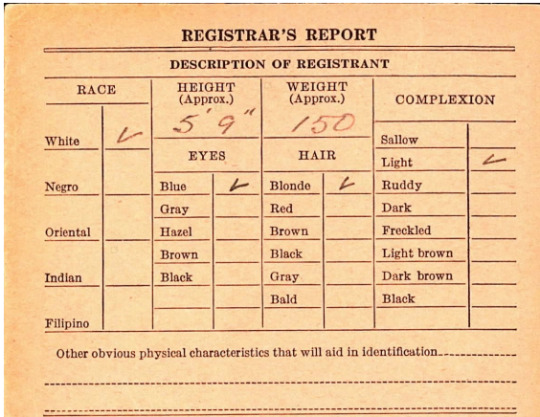
10 March 1943 Long Beach Press Telegram
The newspaper article where De got on the bus to go to Basic. (Mentioned in "From Sawdust to Stardust"). (Article was saved in my "military" folder instead of "newspapers", which is why it wasn't posted before.)
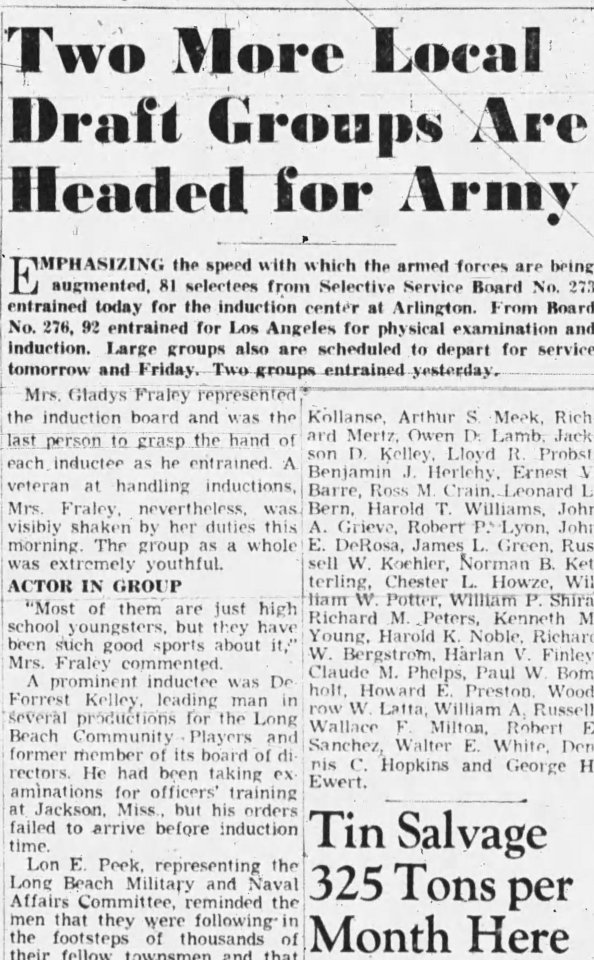
Payroll RAAF, Roswell NM 30 Apr 44
I don't know why this was included in his record, but I love finding records like this so I included it.
Going from left to right, 3 Mar 43 (date drafted). 0 is Years of Service (it's weird in the military: if you're in, but below 2 years, you're still considered having 0 years of service until you hit that 2 year mark, at least on pay records). With the comment under his name, it appears De stopped an allotment in February, and they are now reimbursing him for taking it after he wanted it stopped. If the codes are the same as today, an "F" Allotment is to a charity or emergency assistance fund. Blacked out is his Serial Number. The 6.60 is for an "N" Allotment which is life insurance. 3.75 is for "Class A pay reservations" which is a war bond as far as I can tell. 1.50 is for "Government Laundry."
In the second picture, I could not decode what the 10.35 was for (T/A). So he was due 65.65, but they collected the 1.50, leaving him with 64.15. He signed (with "Jackson" now) saying he received that money.


Separation 28 Jan 1946 -
After VE and VJ day, the First Motion Picture Unit was shut down and some of the unit was sent to Colorado to wait for their separation orders.
Separation Qualification Record
Lists his military jobs, basic information, and a summary of military occupations, which would likely have been useful for returning GIs to get a job doing something similar to what they did in the service, for example, radio technicians, communications, etc. The address on Normandie is where he and Carolyn started renting right before they got married.

Page 2 (Backpage), Military Education, Civilian Education and occupations. Again all of this would be helpful for returning GIs.
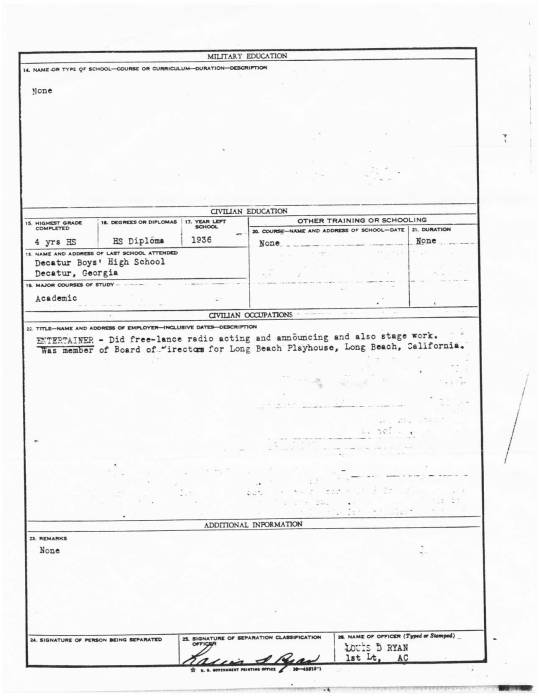
Honorable Discharge Certificate

WD AGO Form 53-55 - Official Separation Form
Basic information. Same address on Normandie as above. Blue eyes, but now Brown hair and weight is 165 (Guess 3 meals a day and all the PT helped him out 😂 Or Carolyn made him some good food 🤣). No. Depend-1, this is number of dependents, being spouse or children, or even at this time parents as the rules were more lax on supporting your parents.
Block 21 Civilian Occupation "Checker" - I'm unsure about this but according to "From Sawdust to Stardust" De told them he was an "entertainer." Box 35 is Immunizations, which continues in Box 55. I'm surprised by how late he got these. Perhaps the Army gave priority to those going overseas first and then the rest got them. Nowadays you get the majority at Basic Training if you don't already have them.
Served 2 years, 10 months, and 13 days, and was a Private First Class upon discharge. Reason for separation is basically "surplus." Pay Data was his final pay plus some travel money, and his insurance continued for another month.
Block 34, right thumb print. Box 55 Remarks: the continued immunizations. Inactive service is while he was waiting to board the bus to Basic, (the time between when he was notified he was drafted and the day he officially was).
The "6 Days lost" is throwing me. Usually "Days lost" means you weren't able to work because you made a bad choice (like you're hungover, or you did something incredibly stupid and hurt yourself, causing hospitalization, or you didn't show up for most of your shift) but I can't see De being too hungover to work or not showing up. However, there is the story of him, George Reeves, and another soldier getting lost in Colorado, pushed a car into the nearby town, and when they couldn't get the hotel owner to open up, they broke in and slept on the floor. They were drunk after drinking a bottle of bourbon trying to stay warm. The sheriff came by and took them to jail for the night. There's also the story of George Reeves getting recognized in Colorado at a hotel and decided not to spend the night because he got mobbed (De was with him). A sheriff pulled them over for something and decided to put them in jail for the night. I don't know if these two stories are the same or not, one was in the book and one was in a newspaper article, but if it made them late or made them miss a shift, that would count as being absent, (but not AWOL, which would have been much more serious). Also I don't know if the furlough time was considered "lost time". It's possible all of this was and it added up to the 6 days.
The 4 Discharge Emblems were pins issued to be worn on the uniform once someone was discharged. Since there was a clothing shortage, service members were authorized to wear their uniforms even after they were discharged (mostly while traveling home). The Discharge Emblem proved that they weren't away from their unit, that they were allowed to be wherever they were. ASR score was a rating given to service members to list who got discharge papers first.
De signed and he was now a Veteran and a civilian. Back to Carolyn at Normandie and Paramount.

#deforest kelley#militaryservice#this concludes our history lesson on WWII Documents#well De's military documents#fascinating
46 notes
·
View notes
Text
Trade wars may ‘bloc up’ world trade
Digital Elixir
Trade wars may ‘bloc up’ world trade
With the recent souring of relations between China and the US, the notion of trade wars is no longer consigned to academic treatments of the disastrous interwar period (Bown and Zhang 2019). Indeed, trade wars have re-emerged as a topic of considerable interest to policymakers. And naturally, observers have been quick to draw parallels between recent changes in commercial policy and the experience of the world economy in the 1930s.
But what precisely were the causes and consequences of the trade wars in the 1930s? Were there perhaps deeper forces at work in reorienting global trade prior to the outbreak of WWII? And what lessons may that particular historical episode provide for the present day? In a new paper (Jacks and Novy 2019), we attempt to answer these questions. But at the same time, we emphasise the limits of historical parallels across two time periods with some common features that nevertheless emerge from very different environments.
Post-war recovery of global trade
After suffering through the short-lived worldwide deflationary episode of 1920-1921, world exports grew by 82.5% in the eight years from 1921 to 1929 (see Figure 1). Additionally, the distribution of world exports as depicted in Figure 2 was quickly converging to its pre-war equilibrium. In 1929, European exports were 53.9% of the world total (as compared to their 57.7% share in 1913) Thus, the global economy seemed well on its way to a successful recovery from the trauma induced by WWI.
Figure 1 World exports, 1920-1939
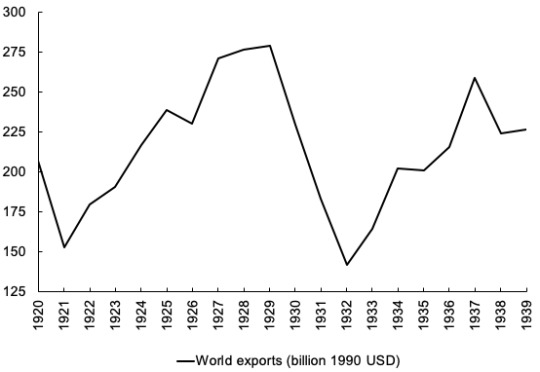
Data source: Jacks and Tang (2018)
Figure 2 Shares of world exports, 1920-1939
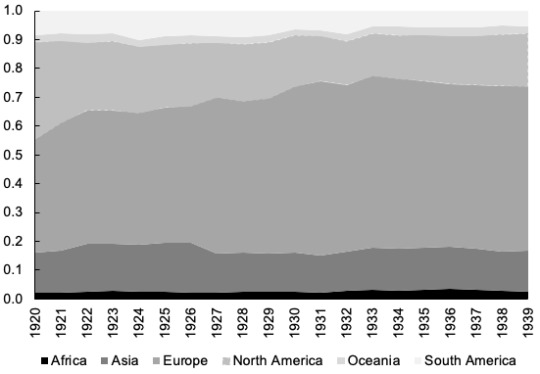
Data source: Jacks and Tang (2018)
The twin shocks of 1929
However, all such expectations faded shortly after 1929 when two large shocks emerged in the world economy. The simultaneous decline in global economic activity and the drafting of the Smoot-Hawley tariff bill from the summer of 1929 (signed into law in June 1930) constituted serious threats to the two drivers of the 1920s trade boom: buoyant incomes and relatively open commercial policy.
In combination with other factors, these two forces drove world trade to a screeching halt. A trade collapse set in from 1929 to 1932 with real exports down by 49.1%, as seen in Figure 1. As both cause and effect of this drop, much of the protectionism of the 1930s was built on the foundation laid during WWI, giving rise to the substitution of exchange controls, licensing systems, and quantitative restrictions for tariffs as the primary levers of commercial policy.
Trade blocs and trade wars in the 1930s
However, the overwhelming aim of both tariff and non-tariff barriers was as a defence to the deflationary forces embedded in the global economy, particularly for those countries that remained wedded to the gold standard (Eichengreen and Irwin 2010). Thus, protectionism was exercised primarily against all trade partners and in a distinctly uncoordinated fashion with instances of bilateral retaliation being relatively minor in comparison (Gordon 1941).
Instead, bilateralism was most prevalent in the series of concessions and treaties that were signed throughout the 1930s. For instance, the Imperial Economic (or Ottawa) Conference of 1932 had as its main purpose the promotion of intra-imperial trade, primarily through preferential concessions to Commonwealth members negotiated on a strictly bilateral basis (Jacks 2014). One of the underlying goals of a number of such treaties was, then, the strengthening of existing trade blocs, primarily centred on Germany and the UK and at least partially geared towards securing food and raw materials on the basis of national security concerns (Kindleberger 1989).
Thus, the theme of trade blocs has dominated the academic literature on interwar trade (Eichengreen and Irwin 1995).
Bloc gravity in the interwar period
To isolate the effects of bloc formation on interwar trade, we consider the well-established gravity model of international trade. Over the past 20 years, the gravity model has emerged as the incontestable workhorse of empirical international trade. By now, a very large literature documents its applicability both over particular episodes in the history of globalisation and in the long run (Jacks et al. 2011). Moreover, it has been shown that gravity equations can be derived from a wide range of leading trade models.
But what do we mean by gravity? Simply that, at the bilateral level, trade is governed by the attractive force of economic mass and is mitigated by the presence of trade costs. Thus, gravity models indicate how consumers allocate expenditure across countries subject to trade frictions.
We use a data set of annual bilateral trade flows from 1920 to 1939, covering 53 countries and constituting 82% of world GDP over this period. We consider two trade blocs (the Commonwealth and the Reichsmark bloc) and two currency blocs (the gold bloc and the sterling area), also controlling for time-varying country-level features.
Figure 3 depicts the value of bloc dummy coefficients in every year for our four blocs – within the Commonwealth, within the Reichsmark bloc, within the gold bloc, and within the sterling area (normalised to 100 for the year 1920). The most striking observation is the rise of within-Commonwealth trade – the Commonwealth coefficient more than doubles throughout the interwar period, reaching a value of 269 in 1939. It shows a particularly strong upward trend after 1931, suggesting an intensification of trade within the Commonwealth due to the imposition of discriminatory trade policies by Britain (de Bromhead et al. 2019).
Figure 3 Bilateral trade within blocs, 1920-1939

Note: Coefficients for bloc membership by year, normalised to 1920 = 100
In Figure 4, we plot distance elasticities for each bloc that are allowed to vary over time. That is, we allow for a triple interaction of distance by time by bloc. Again, we normalise these coefficients to 100 for the year 1920. What is most remarkable from this figure is the fact that the distance elasticity for the Commonwealth (1) is consistently falling throughout the 1920s and 1930s in absolute magnitude, and (2) attains a value of zero in 1939.
In summary, we conclude that interwar trade patterns can be roughly characterised by two dominant observations. First, there was a persistent long-run trend towards the ‘death of distance’ in the context of bilateral trade flows within the Commonwealth, but decidedly nowhere else. Second, there were substantial increases in bilateral trade flows within both the Commonwealth and the Reichsmark bloc from 1931 and 1932, respectively. However, in the case of the Commonwealth, the trade collapse of 1929-1932 and its related trade wars seemed to only reinforce a pre-existing trend built around a surging trade bloc, spanning nearly all continents of the globe.
Figure 4 Bilateral distance elasticities within blocs, 1920-1939

Note: Value of regression coefficient for distance by year, normalised to 1920 = 100
The lessons and limits of historical parallels
We offer up some final observations, highlighting the lessons and limits of historical parallels as they relate to the notion of trade wars. First, the present day does seem to share some common features with the 1930s. In particular, there is the prospect of a formerly dominant multilateral trading system in danger of being replaced by a set of bilateral ‘deals’, initiated primarily by the current US administration. But so far, we have not witnessed a wholesale collapse of the modern trading system. This is partially due to the fact that policymakers seem to have learned some of the lessons of interwar history by not responding in a general fashion to unilateral moves toward protectionism.
This does, however, raise the prospect that the trade wars of the present day may serve the same purpose of those in the 1930s – that is, the intensification of existing and nascent trade blocs. In this vein, it requires no great imagination to see a future in which consumers’ preferences, firms’ perceptions of uncertainty, and states’ apprehensions of one another endogenously lead to a reorientation of world trade around China- and US-centric trade blocs.
The composition of trade and global value chains
Of course, one particularly telling difference of the present day from the interwar period comes from the composition of trade. The interwar trading system was still dominated by inter-industry trade. In contrast, manufactured goods now constitute the overwhelming majority of world exports, and the subsequent fragmentation of production has given rise to both a heightened sensitivity of trade flows to protectionist measures and a heightened sense of mutual interdependence across countries (Baldwin 2016). Thus, the extent to which global value chains can be unravelled arguably places limits on how far this prospective bloc-based trajectory for world trade might proceed.
References
Baldwin, R (2016), The Great Convergence: Information Technology and the New Globalization, Harvard University Press.
Bown, C, and E Zhang (2019), “Trump’s 2019 Protection Could Push China Back to Smoot- Hawley Tariff Levels”, PIIE Trade and Investment Policy Watch (May 14).
de Bromhead, A, A Fernihough, M Lampe, and K H O’Rourke (2019), “When Britain Turned Inward”, American Economic Review, 109 (2), 325-352.
Eichengreen, B, and D A Irwin (1995), “Trade Blocs, Currency Blocs and the Reorientation of World Trade in the 1930s”, Journal of International Economics, 38 (1), 1-24.
Eichengreen, B, and D A Irwin (2010), “The Slide to Protectionism in the Great Depression: Who Succumbed and Why?”, Journal of Economic History, 70 (4), 871-891.
Gordon, M S (1941), Barriers to World Trade: A Study of Recent Commercial Policy, New York: The Macmillan Company.
Jacks, D S (2014), “Defying Gravity: The 1932 Imperial Economic Conference and the Reorientation of Canadian Trade”, Explorations in Economic History, 53 (1), 19-39.
Jacks, D S, C M Meissner, and D Novy (2011), “Trade Booms, Trade Busts, and Trade Costs”, Journal of International Economics, 83 (2), 185-201.
Jacks, D S, and D Novy (2019), “Trade Blocs and Trade Wars during the Interwar Period”, CEPR Discussion Paper 13716.
Jacks, D S, and J P Tang (2018), “Trade and Immigration, 1870-2010”, NBER Working Paper 25010.
Kindleberger, C P (1989), “Commercial Policy between the Wars”, in P Mathias and S Pollard (eds.), The Industrial Economies: The Development of Economic and Social Policies, Cambridge: Cambridge University Press.
Trade wars may ‘bloc up’ world trade
from WordPress https://ift.tt/32UtOnw
via IFTTT
0 notes
Text
UNFORGETTABLE EXPERIENCE: Army Cadets Visit Canadian Battlefields And Acquire Deeper Understanding Of War
(Volume 24-01)
By Army Cadet Sparsh Kapar
Summer vacation ... the most anticipated time of the year for many high school students, as school comes to an end. This is a time that most teenagers spend partying, playing video games, taking on a new job, earning high school credits through summer school, or even just relaxing at home. I, however, did something different: from July 19 until August 6, 2016, I took part in the first ever “Royal Canadian Army Cadets (RCAC) Voyage in History” in Europe. The purpose of this exchange was to have cadets witness, experience, and acknowledge the struggles Canadian soldiers faced in the Great War and the Second World War by visiting historical and battlefield sites related to these conflicts. Only 31 army cadets from across Canada were selected to participate in this exchange, and I am very honoured to be one of them.
Prior to the exchange, I was given an assignment. I was provided with the name of a WWI soldier, Private Island Bellwood Fish, and I was tasked to research information about his life both in and out of the war. Prior to our departure for Europe, I arrived in Ottawa to meet up with the other 30 cadets who had been selected to take part in this exchange. In preparation for our trip, we went to the National War Museum and Library and Archives Canada to gather more information on the lives of our assigned soldiers. We all had the opportunity to touch, smell, and witness the documents our soldiers had written during their time. I’m sure that for most of us, it helped to further develop our understanding and gain more insight on our soldier and their experiences.
Our Europe trip began with the first stop at Amsterdam, Netherlands. It was quite a shock to see the cultural differences from Canada. The streets were congested by bikers and pedestrians. I felt as if I was going back in time by witnessing the detailed, yet aged and marvellous architecture, as well as the city’s vast and gorgeous canal system. It was also quite an eye-opener to see how liberal the people are in Europe compared to Canada. Shops are open in later hours of the day, people are more relaxed with their work, and the cities are very festive at night from all the partying.
While we were in Amsterdam, we stopped by Anne Frank’s house and visited the Holten Canadian War Cemetery. I have read certain stories about Anne Frank in the past, but to see in person just how secluded she was from society by never opening her windows, living in another half of the house behind a bookcase, and even having a schedule to use the toilet gave me a reality check. I’ve complained about a lot of silly things in my life — from not being able to connect to Wi-Fi to not catching a strong enough Pokémon in Pokémon Go — but this experience gave me a new perspective. I, for one, can admit that I have taken for granted the numerous life-changing opportunities I have received living here in Canada. Sure, I may have had some difficult days, but I never had to endure hardships like Anne Frank did. Overall, I have gained a lot more appreciation for the life and the opportunities I get to experience every day.
The Holten Canadian War Cemetery was another powerful moment in the tour, and it was the first battlefield memorial we got to visit. I felt a really eerie presence as I walked alongside the rows of graves of the fallen soldiers with my friends. It was such an overwhelming feeling to see how many soldiers died in one battle, and that doesn’t even account for all the other soldiers who fought in the war.
After touring the Netherlands, our next stop was Bruges, located in Belgium. Bruges is filled with architecture that is over 400 years old and tourist shops, and is known for fries, chocolates, and their signature mouth-watering waffles. Unfortunately, for most of us, our wallets nearly blew out from all the souvenirs we had bought! While we were in Belgium, we were able to see a marvellous memorial, the Menin Gate, located outside of Ypres. The Menin Gate is one of the largest memorials we witnessed, listing over 54,000 names of unknown and unfound soldiers, 6,940 of them being Canadian.
The city of Ypres was occupied by the Germans in both World Wars, and the people of the city know not to take their freedom for granted. Since 1928, the last post ceremony takes place here every evening, and hundreds of people come to watch it. Our exchange group had the opportunity to be a part of the ceremony. We marched in with the Belgian cadet group along with a spectacular band and choir; we also laid a wreath in remembrance to the fallen soldiers who were never discovered after the war.
After our stay in Belgium, we headed into France and spent the remainder of our trip there. During our seven-day stay in France, our exchange group went all over the country, visiting both WWI and WWII battlefields and memorials. Some of the major monuments we visited were Beaumont-Hamel, Juno, Dieppe, and Vimy — sites that pay tribute to the sacrifices and contributions of Canada’s soldiers in various battles.
At Vimy, we presented our research assignments that had been given to us prior to departing on this exchange. I also had the chance, along with the rest of the exchange group, to find the name of my soldier engraved onto the awe-inspiring monument. I, for one, can say that each and every single presentation was outstanding! From letters and posters to speeches, and even telling a story with pictures, it felt as if the lives of these soldiers were really brought back to life! It was really inspiring to see all my friends recognize the efforts that our soldiers put into defending the country we proudly call Canada today!
The presentations were more than just honouring the lives of our fallen men; they were life lessons that each and every single one of us had learnt by looking at how our soldier endured his time in the war and the personal impact it had on his life. When I presented the story of my soldier I emphasized that I learnt that, no matter who you are, you still can achieve anything and make a big difference in people’s lives.
As our exchange neared its end, we were fortunate enough to spend the day touring the marvellous city of Paris! We spent our time seeing l’Arc de Triomphe, le pont Alexandre III, as well as the magnificent Eiffel Tower!
This exchange program concluded with a closing ceremony held at the National War Museum in Ottawa. I had the honour to be an emcee in front of honourable military staff from all over the country, such as BGen (ret’d) Romses, Colonel Commandant of the RCAC, Mr. Robert Gill, and many more! Each cadet received a commemorative coin engraved with their name as well as the name of the soldier whose story they had presented at Vimy Ridge.
Looking back at my life, I am greatly privileged and honoured to have joined the cadet program at the age of 12. I started off being hesitant to try new activities, but as time passed and I became more confident, I was given experiences I’ll never forget for the rest of my life! I had the chance to travel across the Rocky Mountains as part of a leadership course in Alberta; ski and snowshoe in Sleeping Giant Provincial Park in Thunder Bay, Ontario; and spend the best summer of my life in Europe! It was such a pleasure to represent my cadet corps, 2990 Lorne Scots Army Cadets of Milton, as well as Canada, as I honoured the lives of our fallen soldiers by visiting monuments and presenting that information back home. I have forged inseparable friendships, tried a bunch of mouth-watering delicacies, and experienced a totally different culture, all thanks to the Army Cadet Program! It truly is the greatest youth program Canada has to offer, and I just can’t imagine my life had I not participated in it!
0 notes